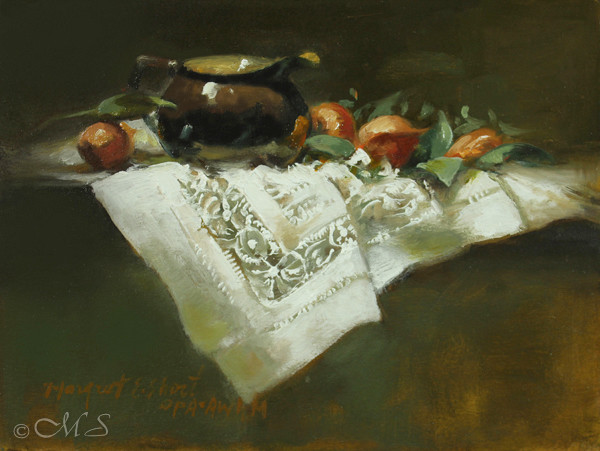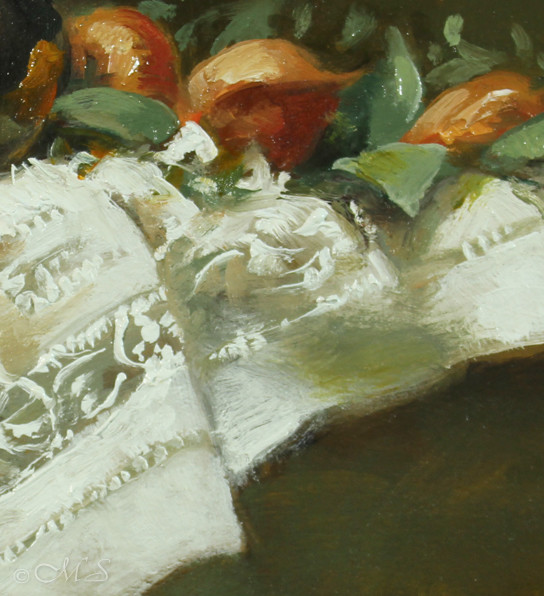Making stitches and threads with paint has become a daily endeavor. The newest Iso-LACE-tion piece is finished and on the drying rack. In my studio, finished paintings go on a shelf to dry by means of low heat from a tungsten light bulb which accelerates the drying time. Although when you think about it, there is really no hurry these days.
Efficiency in a Limited Palette

Sticking with a limited palette for modelli facilitates the working process. This simplifies not only the planning but also color mixing, decision making, and clean up. Here, in Interlace Modello, very few colors were used. Ivory black, vermilion, flake white, yellow ochre, permanent alizarin crimson.
A mixture of yellow ochre and black make a nice subtle green. This color combination with the addition of white is the go-to formulation I use for most white objects and fabrics. Mix yellow ochre and white with a smidge of black for the lighter values. Carefully add more black and less white for the darks.

Avoid Sinking-in Problems
Though it is a beautiful color, I seldom use burnt umber anymore. Because of its clay content, sinking-in can occur and become a real nuisance. Sinking-in is a phenomenon where areas flatten, and no matter how much medium or oil you use, it will remain dull and lifeless. This is a troublesome issue when varnishing. The varnish resists adhering to the surface and will ‘crawl’ or bead-up rather than flow smoothly across the surface. Try using a facsimile to burnt umber by mixing burnt sienna with ultramarine blue. It is a perfect substitute and will not cause headaches.
Yes, Kafka said, “Isolation is a way to know ourselves,” and I can’t think of a better description for today’s events, can you?

Margret, is this an issue with all burnt umbers? I have noticed it with some, but have no idea of the range of this result across paint companies.
Thanks
Hello Louise, Of course, I can’t speak for all burnt umbers, but sinking-in has been a troublesome issue for years. Some time back, I read in a technical book that the clay content in this particular pigment can cause sinking-in. Right about that time I was varnishing a small painting that kept beading-up and no matter how many coats I put on, the varnish would not cover the surface evenly. I decided to avoid using BU, or mix other pigments into the umber such as ultramarine blue and burnt sienna. This seemed to work. So this has become my standard practice now. Hope this helps.
I will be an artist before you know it. All of your tips and explanations of why to use certain colors and why, makes me want to pick up a palette and brushes. Then reality sinks in.
I shall just enjoy the 5 wonderful painting you have done for me and salivate over others. You are remarkable in every way. Every household needs a Margret Short painting and enjoy art through your eyes. Enjoy your blogs.
Well, my goodness, I am so happy that you are enjoying the paintings in your home. It was my pleasure. So glad you are also enjoying the blogs. Who knows maybe you will pick up that paint brush some day. We could go out painting together!!
What is it that Franz Kafka was supposed to have said?
Hello Susan,
“Isolation is a way to know ourselves” is the Kafka quote I used in my previous blog post. This quote is attributed to him, and I can’t think of a better thought than this to describe today’s world events. Thanks for your inquiry.